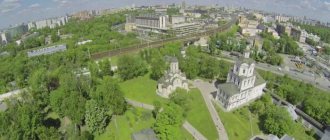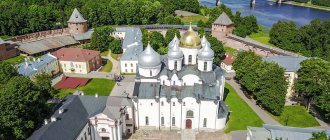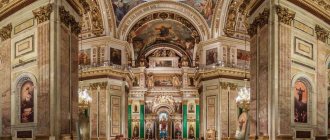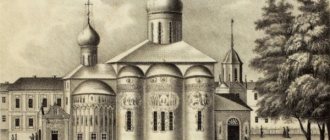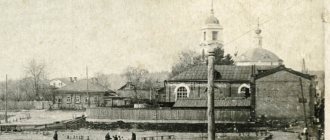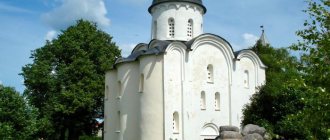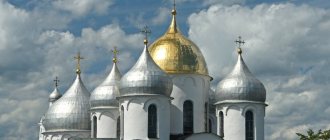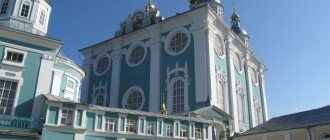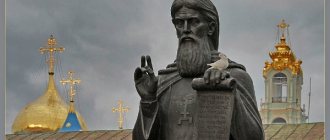History of the temple
Construction of the monastery near the Istra River began in 1656 under the leadership of the great Russian Patriarch Nikon and lasted 113 years. The lack of knowledge of the masters in the field of architecture was more than compensated for by numerous experiments: the built parts were dismantled, and new ones were erected in their place. In 1666, the last elements of the building were completed: a large dome and a tent over the rotunda.
The Resurrection Cathedral of the New Jerusalem Monastery is a history of cultural heritage.
And in the winter of 1685 it was consecrated in the presence of representatives of the royal family. After its consecration, the monastery was repeatedly plagued by misfortunes. In 1723, the hipped roof of the rotunda fell down. In 1726 a fire broke out. And in 1759 the building was almost completely destroyed.
The first reconstruction began during the reign of Empress Elizabeth Petrovna. With her donations, the interiors were decorated with paintings, mosaics and stucco, and the area was landscaped.
In 1780 - 1792, at the behest of Empress Catherine II, all the burnt buildings were rebuilt, and on the first floor of the Nativity Church of the monastery a Nativity den, chapels of the Circumcision of the Lord and the Adoration of the Magi appeared. In the 19th and 20th centuries, the monastery became the most popular and visited center of pilgrimage throughout the world.
During World War II, the retreating troops of Nazi Germany blew up the monastery. Most of the building was destroyed and most of the shrines were lost. Miraculously, only the Chapel of the Holy Sepulcher and the crucified Christ on Calvary survived.
The second full-scale restoration of the monastery began only in the mid-90s of the twentieth century. In 2011, the entire surrounding area was put in order: images of the Virgin Mary with a child in her arms and valuable mosaics by the artist Vasnetsov. Now the history of the cathedral and its shrines can be read on the snow-white slabs decorating the arched vaults at the central entrance to the temple.
Architect and exterior decoration of the cathedral
The exterior decoration of all buildings in the complex is made in the classic national Baroque style. They look elegant and evoke associations with fairy-tale towers. The main author of the architectural ensemble is Patriarch Nikon.
Such great masters as Stepan Polubes, Pyotr Zaborsky and Ignatius Maximov worked on ceramics.
Architectural ensemble of the cathedral
In addition to the cathedral, the ensemble of the monastery complex includes more than a dozen other buildings made in the same style:
- Church of the Nativity and refectory chambers. The complex is in the Moscow Baroque style, consisting of spacious rooms arranged in a line, the facade of which is adjacent to a single-domed two-story church. In the 18th century, the baroque gallery was replaced by an arcade in the classical style, and four chapels dedicated to gospel subjects appeared on the lower tier of the church. In 1941, the refectory chambers were destroyed by fire, but the temple miraculously survived. Its façade retains 17th-century details and valuable paintings.
- Underground temple . A single-domed temple buried in the ground, adjacent to the central cathedral from the east. It appeared in such an unusual place in connection with the legend of a crucifix found at a depth of six meters.
- Church of the Entry of the Lord . It was erected together with the gates that are its integral part, and consecrated in the winter of 1697. Serves as a symbol of the entry of Jesus Christ into Jerusalem. During the Second World War it was destroyed, and at the end of the twentieth century it was restored and given to a historical and art museum.
- Fortress fences . Stone fences erected in place of wooden ones in 1690 -1697 under the leadership of Yakov Bukhvostov. They are nine meters high and more than a kilometer long. At the top of the walls there are a number of loopholes, and on the breaks there are seven towers with unusual Palestinian names.
- Epiphany Skete . Chambers adjacent to the church and belfry, dating back to 1657: for household needs, for cell attendants, for meals and for “receptions” of parishioners.
- Mount of Olives. A high hill on which there is a small chapel and a stone worship cross, marking the place where the Ascension of the Savior took place.
- Necropolis. Old burial grounds flank both sides of the Underground Church, where there are more than a hundred well-preserved tombstones.
Don't miss the most popular article in the section: Metro Nizhny Novgorod. Diagram, map, description.
Description
| The main entrance to the Church of the Resurrection of the Lord. To the left of the entrance is the Column of the Holy Fire. At the top right is the Chapel of Our Lady of Sorrows. |
Main entrance
Facade of the temple from the entrance
(i.e. from the south) is an example of Romanesque architecture of the 12th century. The double lunettes of the portal originally contained marble bas-reliefs of the Entry of the Lord into Jerusalem and the Burial of the Savior, which were then transferred to the Rockefeller Museum in Jerusalem. On the right, in front of the entrance to the temple (the right door was blocked under Salah ad-Din), there is a wooden hatch covering the tomb of the knight Philip d'Aubigne, who accompanied the German Emperor Frederick II upon entering Jerusalem in 1229.
Column of the Holy Fire
– one of the marble Corinthian columns decorating the portal on the left. It was miraculously split almost in half on Holy Saturday 1634. In connection with the disputes that arose about Easter (the Orthodox celebrated Easter that year on April 6, a week earlier than the anti-Chalcedonite Armenians), the Ottoman authorities, at the insistence of the Armenian governor, locked the temple, not allowing the Orthodox to attend the service of the Holy Fire. Through the prayer of Orthodox believers who had gathered at closed doors, led by Metropolitan Parthenius of Bethlehem and Archbishop Athanasius of Gaza (Patriarch Theophan IV was not in Jerusalem at that time), lightning struck from a storm cloud and Holy Fire appeared from a crack in a split column [2].
In the right, north-eastern corner of the courtyard, an external staircase leads to a small chapel that served as the vestibule of the Calvary chapel. Nowadays it is called the Chapel of Our Lady of Sorrows
or "Chapel of the Franks", is sometimes referred to as the Chapel of the Removal of the Robes in remembrance of how the Roman soldiers divided the clothes of the Crucified One among themselves. Under the Roman Catholic chapel, on the 1st floor, a separate entrance leads to the Orthodox parecklision of St. Mary of Egypt.
| Stone of Anointing |
Stone of Anointing
Inside the temple, opposite the entrance, lies the Stone of Anointing, covered with a red polished marble slab 30 cm thick, on the sides of which the Greek text of the troparion to St. Joseph of Arimathea is carved around the perimeter. The corresponding Gospel text (John 19:38-40) is written in Greek on a marble plaque hanging on the right. The removal of the Cross from the Lord, the anointing of the body with incense and the position in the coffin are depicted on a large mosaic panel, stylized as a Byzantine pattern, on the wall directly behind the Stone of Anointing. The mosaic was completed with the blessing of Patriarch Diodorus in 1990 by V. Tsotsonis. Above the Stone there are 8 lamps (4 - Orthodox, 2 - Armenian, 1 - Latin, 1 - Coptic).
There is no evidence reaching us about exactly where the body of the Lord was prepared for burial. But since the century, the rite of Burial of the Shroud has been prominent in the observance of Good Friday. In the temple it is performed as follows: the shroud covered with rose petals is transferred by 6 bishops from Golgotha to the Stone of Anointing; after the litany at the Stone, the shroud is solemnly transferred with a threefold litany around the Edicule and placed on the Triday Bed, then taken to the altar of the catholicon.
| Edicule, general view from the north. Photo beginning 2000s |
Chapel of the Holy Sepulcher (Edicule)
The Chapel of the Holy Sepulcher, or Edicule, stands to the left of the Stone of Anointing, under the arches of the rotunda. On the sides of the entrance to the Edicule there are low marble barriers with benches, behind which there are tall candelabra belonging to the Roman Catholics. Above the door there are lamps hanging in 4 rows (13 each for Orthodox, Roman Catholic and Armenian). One of the decorations of the Edicule is a Russian carved silver canopy from the 1st half of the 19th century with 12 icons of the Holy Apostles using the Rostov enamel technique. In 2004, by order of the Jerusalem Patriarchate, the ancient enamel was replaced with new ones, manufactured using modern technology by the Rostov company A. Rudnik.
Edicule
(8.3x5.9 m) consists of 2 parts: western, hexagonal in plan (2.07x1.93 m), where the Holy Sepulcher is located, and eastern (3.4x3.9 m), where the Angel's chapel is located .
A pedestal with a part of the sacred stone rolled away by an angel is located in the middle of the chapel and serves as a throne during the celebration of the bishop's Orthodox liturgy at the Holy Sepulcher (in this case the Triday Bed itself becomes the altar). There are 15 lamps in the chapel (in 3 rows, according to the number of main confessions). In the northern and southern walls there are oval windows for the transmission of the Holy Fire on Holy Saturday (northern - for Orthodox, southern - for Armenians). The entrance from the Angel's chapel to the Cave of the Holy Sepulcher is decorated with a marble portal. On the left at the entrance are depicted the myrrh-bearing women, on the right is the Archangel Gabriel stretching out his hand to them (according to the inscription), at the top of the portal is a marble canopy with an inscription in Greek, reproducing the words of the angel: “ Why are you looking for the living among the dead?
He is not here, He has risen ."
| Edicule scheme |
The Cave of the Holy Sepulcher
is a small chamber, almost half occupied on the right by a stone bed covered with a marble transenna slab. The slab appeared in Kuvuklia in 1555. Maxim Simeos, who was the last to see the Savior’s stone bed without a slab covering it in 1810, testified that it was severely damaged by the unreasonable jealousy of countless “God-lovers” who strove to break off, bite off, and take away a piece of the shrine at any cost. In the western part of the slab, due to the zeal of the pilgrims, a noticeable depression was formed. On the marble shelf running along the sides of the Triday Bed, there are 3 icons of the Resurrection (from each of the Christian confessions). The ktitor inscription above the door names the creator of Edicule - the Greek architect N. Komninos, who was martyred by the Turks in Constantinople on Easter 1821.
In the western part, the Chapel of the Head
, belonging to the Coptic Church. According to legend, the second angel sat here (“at the head”) (John 20:12). Since Byzantine times, a small throne existed on this site. The Crusaders called the chapel "cavet" ("head" in Norman dialect) because it was located at the head of the Edicule. According to Armenian sources, the chapel was built by the king of Cilician Armenia, Etum II, in 1300. Subsequently, the Armenians gave this chapel to the Copts, receiving in return one of the monasteries in Egypt. In 1810, the Orthodox Greeks reconstructed the Edicule without the Coptic chapel, which was restored 30 years later at the direction of the then ruler of Palestine, Ibrahim Pasha, son of the Egyptian Khedive Muhammad Ali. Coptic monks cite a legend that during the reconstruction of the edicule in 1810, the niche of the Holy Bed was truncated in the western part, so that the place where the head of the Savior rested ended up in the Coptic chapel.
Rotunda
Many chapels are located around the edicule in the rotunda, which is divided vertically into 3 tiers. The 2 upper tiers are supported by 6 square pillars and 10 Corinthian columns. In 1810, in order to strengthen the structure, the western pillars and columns were connected by a wall and the outer ring of the rotunda was divided by partitions into separate small rooms and storage rooms. The lower tier of the rotunda has 3 apses on the southern, western and northern sides.
Southern part of the lower tier
belongs to the Armenians. In front of the staircase to the gallery there is a marble ciborium on 4 columns with a 6-sided dome over a round marble slab, marking the place where, according to the legend of the Armenian Church, the Blessed Virgin stood at the time of the Crucifixion. It is believed that in the Byzantine period, the chapel of the Blessed Virgin (or Three Marys), destroyed during the reconstruction of the temple by the crusaders, was located on the site of the modern Stone of Anointing.
Middle tier
The rotunda, which is a balcony gallery with arcades, divided by 16 columns adjacent to the Arch of Monomakh, is divided between the Armenians and the Roman Catholic communities. The galleries on the northern side belong to the Roman Catholics, the southern - to the Armenians (on the Armenian side there are 2 churches in the galleries).
3rd, upper tier
with false arches belongs to the Orthodox. Above, above the wide architrave, is the so-called. a small gallery of 16 arches, under each of which there are 5 lamps, as if embedded in the hemisphere of the dome.
On the gallery there is an Armenian church called the Second Golgotha
(in terms of floor level it almost coincides with the original Golgotha). The church was built with the blessing of the Armenian Patriarch Martiros in 1439, after the Armenians lost the right to own Golgotha. The main shrine of the temple, the Armenians honor a fragment of a column, which their tradition connects with the Column of Flagellation (John 19: 1) [3]. The second throne of the temple is dedicated to Saint Macarius of Jerusalem, during whose presence the discovery and erection of the Cross of the Lord took place.
In the western apse
, opposite the Coptic chapel, there is an Armenian (formerly Syrian) chapel of St. Nicodemus. A small passage in the southwestern wall leads to 2 tombs (type of Hebrew nish-kokkim) of the righteous Joseph of Arimathea and Nicodemus.
Northern part of the rotunda
belongs to the Roman Catholics. Near the Edicule is the throne of St. Mary Magdalene. Above it, on the eastern side of the pillar, is a modern cast relief image depicting the meeting of St. Mary Magdalene with the Risen Savior.
Roman Catholic Franciscans own the Church of the Apparition of the Risen Lord to the Blessed Virgin Mary
. The main shrine of the temple, Roman Catholics honor the fragment of a porphyry column located to the right of the altar, in a special niche, which their tradition connects with the Flagellation Column (John 19: 1) [3]. Previously, this church was part of a single ensemble; it housed the open courtyard of the Greek Patriarchate. From the western part of the temple you can go to the Franciscan monastery, attached to the northern part of the temple complex. In the same church, the place is venerated where, according to legend, a dead woman was resurrected from touching the Life-Giving Cross of the Lord on the day it was found.
To the right of the Franciscan chapel, behind a massive oak door, is the Roman Catholic sacristy.
, where the main attraction is the sword and spur of Godfrey, the commander of the crusader army that took Jerusalem in 1099. These relics are used in the ceremony of initiating knights of the Holy Sepulcher by the Latin Patriarch.
Triumphal Arch
By a low, one-step podium, the Edicule is connected to the Triumphal Arch (or the Arch of Monomakh, named in memory of the Eastern Roman Emperor Constantine IX Monomakh, who restored the temple in 1048) and the Church of the Resurrection that opens behind it. The lintel under the arch contains an inscription in Greek from the side of the katholikon: “ Hail, O Zion, holy Mother of the Churches of God
! In the passage of the arch there are small balconies on the left and right, facing the Edicule, on which, until 1917, consuls and other honorary representatives of the main Orthodox powers - Russia and Greece - were located during ceremonial services.
Church of the Resurrection of the Lord (Katholikon)
Previously, the temple complex of the Holy Sepulcher consisted of several separate sanctuaries: a rotunda directly containing the Edicule, Calvary (Orthodox and Roman Catholic) chapels and the cathedral church of the Jerusalem Orthodox Patriarchate. The Crusader Basilica united these objects in a single internal space. Nowadays, the “middle” volume of the temple complex, enclosed by special walls that do not reach the vaults, built after the fire of 1808, is called the katholikon (cathedral church) of the Resurrection of the Lord. The Greek reconstruction of that time changed the composition of the structure: in addition to the side walls, a high iconostasis appeared. From a liturgical point of view, the unity of the temple space was achieved, and the necessary prayerful atmosphere for Orthodox worship was created.
Dome
The katholikon, the smaller of the 2 domes of the temple, is located above the western part. Exactly under the dome, on a special vase-stand, a marble hemisphere is placed, indicating a place called “mesomphalos” - “the navel of the Earth.” The idea of Jerusalem as the center of the earth and the economy of salvation has been known since ancient times (Ps 73:12), but this building appeared in the temple no earlier than 1810. The dome contains a mosaic image of Christ the Pantocrator blessing him, surrounded by the Mother of God, St. John the Baptist, Archangels Michael and Gabriel, and 12 saints. Between the 8 windows of the drum, in the niches, there are images of seraphim and cherubim. The mosaic work in the dome of the katholikon was completed in 1994.
The Catholicon is the cathedral of the Patriarchate of Jerusalem, which is why there are 2 throne seats in its eastern part - the thrones of the Patriarch of Jerusalem at the southern pillar and his representative, the Metropolitan of Petro-Arabia, at the northern one. Above the iconostasis is a gallery with 3 pulpits (small balconies) protruding into the church, from where, according to the ancient Byzantine rule, the deacon should read the Gospel. The entire eastern part of the catholicon, including the iconostasis, the sole with 4 steps, 6 columns on it, the northern and southern entrances to the altar, is a single ensemble of pink marble.
Katholikon Galleries
The Catholicon, like the rotunda, is surrounded by spacious galleries that house several chapels.
In the northern gallery of the temple there is a place called the Arcade of the Virgin
: huge 4-sided pillars supporting high vaults, interspersed with columns, between which stands out a white marble fragment of the building of Emperor Hadrian. It is assumed that of the 7 columns, the 4 central ones belong to the Triporticus of Constantine.
At the eastern end of the gallery there is an Orthodox chapel, indicated on ancient plans as the Chapel of the Ouses or the Prison of Christ
, first mentioned in sources at this place no earlier than a century. This is not an archaeological reconstruction, but an architecturally designed “liturgical model” of the original Prison of Christ. Before entering it, under the throne, there is a stone slab with 2 holes for the feet, where the condemned were put, made by analogy with the shackled stone bench in Pretoria. The Greeks usually call this room the chapel of the Holy Myrrh-Bearing Women, and Russian pilgrims have recently called it the chapel of the Weeping Mother of God, after the 19th century icon of Our Lady of Tenderness located in it, which has been revered as miraculous since 1986. The original purpose of this room is unknown; presumably at the time of the Crucifixion there was an ancient Jewish tomb here; according to another version, the holy myrrh-bearing women came here to the abandoned cave.
At the outpatient clinic
, behind the altar apse of the catholicon, there are 3 more chapels.
The first, Orthodox, is dedicated to Saint Longinus the Centurion. On its marble balustrade is inscribed a verse from the Gospel: “ The centurion and those who were with him guarding Jesus, seeing the earthquake and everything that happened, were greatly afraid and said: Truly this was the Son of God
” (Matthew 27:54).
The next chapel, located in the gallery, belongs to the Armenian Church and is dedicated to the Division of Robes (John 19: 23-24); according to legend, it was at this place that the legionnaires who crucified Christ divided His clothes (at the same time, there is a Roman Catholic throne of the same dedication on Golgotha).
Near the stairs leading down to the Church of St. Helena, there is a chapel of the Crown of Thorns. In the center of the chapel, under the altar, under glass there is a fragment of a thick, round column of gray marble, called the Column of Reproach. According to legend [4], on this column, no more than 30 cm high, the Savior sat at the moment of His crowning with thorns (Matthew 27:29). According to the testimony of Russian pilgrims of the mid-19th century, a part of the crown of thorns was preserved right there “in the wall behind glass and behind bars” [5].
Underground temples
Underground Church of St. Helena
now belongs to the Armenians, who acquired it, according to one version, from the Georgian Orthodox community, according to another - from the Ethiopians. The temple has 2 altars: the northern altar is dedicated to the Prudent Thief; the main, central one - to Queen Saint Helena and her contemporary Saint Gregory the Illuminator. According to Armenian legend, when Saint Gregory, after a long feat of prayer, came to venerate the Holy Sepulcher, he was honored by the descent of the Holy Fire. The small cross-domed temple (20x13 m) was originally the crypt of the basilica of Emperor Constantine. The dome in the center is supported by 4 ancient monolithic columns; the vaults were erected no earlier than the 12th century. The plane of the floor between the columns is covered with mosaics with scenes from the history of Armenia. A special niche and stone seat mark the place in the temple behind the altar dedicated to Saint Helena, where the queen sat during the excavations. There are 3 unquenchable lamps burning in the window.
The Church of St. Helena is connected by 13 steps to the Roman Catholic Church of the Finding of the Cross
, located at the lowest point of the entire temple complex.
Behind the stone throne stands on a high pedestal a large bronze statue of St. Helena with the Cross she found in her hands, donated by the Austrian Archduke Maximilian. In the right corner of the chapel, under a low-hanging rock, lies a small marble slab with a white 8-pointed Orthodox cross on a black background, marking the place where the Honest Tree was discovered. The Cave of the Finding, according to A. A. Dmitrievsky at the beginning of the century, “ is now almost the undivided property of Catholics, but back in 1835 the Greek throne stood here
” [6]. On the Feast of the Exaltation, the Orthodox clergy, led by the Patriarch, performed a solemn litany called the parousia: the procession of the cross left the southern doors of the catholicon and passed through the outpatient clinic to the stairs of the Temple of Helena. Then the procession descended into the Cave of the Finding, where the troparion of the holiday was performed and the Patriarch performed the rite of the Exaltation of the Cross in 4 places - at the ends of the imaginary Cross. Then the religious procession headed to the Edicule and, having circled it three times, ascended to Golgotha, where the rite of the Exaltation of the Cross was repeated [7].
To the left of the Orthodox slab at the site of the Finding of the Cross, from a hole in the wall one can hear, according to the pilgrims, “a hellish buzzing.” “ In essence, this phenomenon occurs because opposite this excavation there is a huge, now empty cistern under the temple
" [8].
In 1970, with the blessing of the Armenian Patriarch, the space to the northeast of the apse of the Church of St. Helena was explored. We discovered a room to which access had been closed since ancient times. This newly found part of the temple was named the Chapel of St. Vardan the General or Armenian Warrior Martyrs
with a passage from the Church of St. Helena. In the center of the chapel there is an altar with a khachkar in the name of 1036 Armenian martyrs who died during the Armenian-Persian War in 451.
| Golgotha Plan |
Calvary
The most important place of worship in the entire Church of the Holy Sepulcher is the Church of Golgotha, which contains the site of Christ's crucifixion. Golgotha acquired its modern architectural appearance as a result of the renovation of the temple in 1810. At the holy place of the Crucifixion there is only the rock itself, which builders and restorers of different eras truncated, leveled, and hewn; today its dimensions are 4.5x11.5x9.25 m. There are 2 staircases leading to the rock: the right one starts immediately from the doors of the temple (“Latin rise” leads to the Roman Catholic side chapel), the left one - from the side of the catholicon (“Greek rise” leads to main Orthodox chapel). 2 naves, separated by squat massive pillars with an arch between them, form the Orthodox and Catholic side chapels of Calvary, which in Byzantine times they formed a single temple.
Orthodox throne
, one meter high, made of pink marble; under the throne there is a hole into which the Crucifixion was placed. The surface of the rock is hidden by a marble floor; only to the right and left of the throne in the glazed openings can one see the gray stone of Golgotha itself and the crack that passed through the entire rock as a result of the earthquake at the time of the Savior’s death (Matt. 27:51).
South aisle of Calvary Church - Nailing to the Cross
- belongs to the Roman Catholic Franciscans. It acquired its modern appearance as a result of restoration in the late 1930s according to the design of A. Barluzzi, after the 1927 earthquake. From the mosaics of the Crusader period, only a fragment of the composition “The Ascension of Christ” on the vault of the central arch has survived. The silver altar (master D. Portigiani from the monastery of San Marco in Florence) was donated to the temple in 1588 by the Grand Duke of Tuscany Ferdinando de' Medici. It is believed that the altar was placed on the spot where the hands and feet of the Savior were nailed to the Cross. It was originally intended for the Stone of Anointing, which explains its elongated shape, but due to friction between denominations, the Franciscans were forced to place it in the chapel of the Church of Calvary.
Under the arch separating the Roman Catholic part of Golgotha from the Orthodox part, there is a Roman Catholic altar "Stabat Mater"
(according to the first words of the prayer of the 14th century Italian Franciscan poet Jacopone da Todi). Behind the throne is a sculpture of the Blessed Virgin with a sword in her chest in accordance with the prediction of Simeon the God-Receiver (Luke 2:35) (the sculpture was donated by the Portuguese Queen Maria I of Braganza and brought to Jerusalem from Lisbon in 1778).
Under the rock of the Crucifixion is the chapel of Adam's head
, otherwise known as the chapel of Melchizedek, who, according to legend, buried the head of the progenitor of the human race here. From here you can see a chasm in Golgotha about 15 cm wide.
From this side-chapel, the door on the right leads to the office-cell of the epitrope of the temple
(former chapel of St. John the Baptist), from where you can go to
the Orthodox sacristy
, where a cross-reliquary with a particle of the Life-Giving Tree and many particles of the relics of saints are kept.
| Church of the Holy Sepulcher. View of the square in front of the main entrance |
Yard and its buildings
The territory of the square in front of the entrance to the temple almost entirely belongs to the Jerusalem Patriarchate. In the left corner of the courtyard there is a bell tower
, built by the French architect Jourdain in 1160-1180. The temples on the left side of the courtyard, with apses facing the western side of the square, have a common entrance to the left of the temple portal, next to the bell tower.
Under the bell tower is the Church of the Forty Martyrs of Sebaste
, which is the tomb of the Jerusalem patriarchs. The cross crowning the iconostasis is supported by 2 carved decorative dragons, symbolizing the consecration of the entire created world by the Calvary Sacrifice.
To the left of the Church of the Forty Martyrs in the open air is the Church of the Myrrh-Bearing Women
, without a roof, only the iconostasis has a small canopy that protects the icons and the interior of the altar. In the middle of the temple, a small white marble ciborium indicates the place of the appearance of the Risen Lord to Saint Mary Magdalene (John 20: 11-18).
To the left of the Church of the Holy Myrrh-Bearing Women, in the western part of the courtyard, is the Church of Saint James, Brother of the Lord.
This church is the parish church for the Orthodox of Jerusalem. In the western part of the temple, in the narthex, there is a miraculous icon of the Mother of God, placed, according to legend, in the place of the one from whom the voice of the Venerable Mary of Egypt came.
From the common lobby of the described temples, a wide stone staircase leads to the 2nd floor, where the patriarchal house church
Equal-to-the-Apostles Constantine and Helena. According to the structure of the Holy Sepulcher Brotherhood, the entire Patriarchate of Jerusalem is a monastery in the name of these saints. The most holy rulers of Jerusalem, as the legal guardians of the main Christian temple, lived in close proximity to it. After the arrival of the Crusaders, the Orthodox patriarch was expelled from Jerusalem and his chambers were occupied by Catholics for some time. Saladin, who in turn expelled the crusaders, returned the temple to the Orthodox, but the patriarchal chambers remained with the new conquerors. The Church of Equal-to-the-Apostles Constantine and Helena was restored after centuries of neglect in 1579 by Patriarch Sophronius IV and updated in 1986. From the decoration of the 16th century to the 21st century, the iconostasis and the royal doors have been preserved, which are now located in the cave church of St. Nicholas the Wonderworker of the Lavra of Sava the Sanctified. Behind the left choir of the church there is a window into the temple, from which the Edicule is visible. One of the ancient icons of the temple is the Jordan Icon of the Mother of God, revered as miraculous. The value of this ancient icon became again known to its keepers after 1835, when the Russian pilgrim A. S. Norov spoke about it, recalling that evidence of this icon as miraculous is contained in the “Walking” of the abbot. Daniel.
The eastern side of the square is occupied by the Orthodox Avraamiev Monastery
, the main temple of which, located on the 2nd floor, has the symbolic meaning of Mount Moriah, i.e. the place where righteous Abraham intended to sacrifice his son Isaac as a sign of submission to the will of God. The true site of Mount Moriah belongs to Muslims, therefore the Orthodox Church symbolically designated in its own liturgical space the most important of the Old Testament events, which was a prototype of the Calvary Sacrifice of Christ, bringing it closer to the place of sacrifice of the New Testament Lamb. The place of Abraham's sacrifice is marked by a marble circle in the middle of the church. From the church there are passages to Calvary and to the altar of the Church of the Resurrection.
Another monastery church of the Twelve Apostles
preserves the memory of the monastery of the same name, which was previously located behind Avraamiev and, according to some sources, coincided in location with the later cloister of the Crusaders (the cells of the Ethiopians are now located here).
Part of the lower floor of the Avraamiev Monastery
also belongs to the Orthodox. The temple has 3 thrones. The main altar, according to legend, was erected on the spot where Evangelist John the Theologian stood during the crucifixion of the Savior (John 19:25-28). On the 2nd, right altar, dedicated to the Passion of the Lord, a part of the Flagellation Column from the house of the high priest Caiaphas is kept. The 3rd throne, located on the left, is dedicated to the sacrifice of Abraham.
To the north of the monastery doors is the entrance to the Armenian church
Apostle John the Theologian.
In the northeast corner of the courtyard, a door between the chapel of St. Mary of Egypt and the Church of St. John the Evangelist leads to a staircase, on the lower flight of which is the Coptic Church
of the Archangel Michael, on the upper flight is
the Ethiopian Church
of the Four Living Creatures (Tetramorph).
The Ethiopian Temple is connected to the terrace
(floor level of the original basilica of Emperor Constantine), in the middle of which stands the dome of the underground church of St. Helena. Here are preserved the ruins of the internal gallery of the crusader monastery of the 12th-13th centuries, which in turn replaced the ancient Abrahamic Monastery, which was part of the Holy Sepulcher complex. Among the ruins are small cells of Ethiopian monks, who were forced onto the roof in 1660, after the loss of their holy places inside the temple.
Behind the site with the Ethiopian monastery are the buildings of the Coptic Patriarchate
, known as Deir es-Sultan (Sultan's Monastery) because it was given to the Coptic community by Sultan Salah ad-Din. The cathedral church of the monastery is dedicated to St. Anthony the Great, the other church is dedicated to St. Queen Helena. In the depths of its elongated room there is a narrow staircase, along the steps you can go down to the cistern of St. Helena - the largest of the cisterns located around the temple. According to legend, it was precisely this that was used during construction by the architects who erected the Church of the Holy Sepulcher.
On the southern side of the square, opposite the entrance to the temple, is Little Gethsemane
- courtyard of the Gethsemane Assumption Monastery. In this small church, last rebuilt and restored in 1953, the shroud of the Mother of God is kept at the altar, in the icon case of the Jerusalem Icon of the Mother of God. The shroud is a two-sided image of the Mother of God, about 1 m in size, carved on a board along the contour. A silver-gilded robe “with crowns shining with precious stones.” In terms of iconography, material and type of execution, the shroud is a work of Russian-Jerusalem church art of the 19th century; copies of it are known in Russian churches.
Interior decoration
At the entrance there is the Stone of Confirmation, which is a copy of the stone slab on which the body of Jesus was laid after being taken down from the Cross. The altar of the temple, symbolizing the unity of earth and heaven, is decorated with the Gate, through which Christ takes on human flesh.
The rich floral patterns covering the Gate are dedicated to the appearance of God at the Burning Bush and the Immaculate Conception. A small Edicule was installed on the site of the Holy Sepulcher. A chapel close to the original, inside of which there is a copy of the stone on which His body was laid.
And above the burial place of the Savior, a luxurious rotunda was erected, connected by a two-tier arch to the main space of the temple. The interiors are designed in a strict color scheme. Baroque stucco is adjacent to monochrome sculptures and light vaults. A carved staircase leads to the second floor, to Golgotha. A separate temple located on the site of the Mount of the Crucifixion.
Design characteristics[ | ]
- The official name of the construction project is “Cathedral with administrative and utility premises and guest parking at Zheleznodorozhny Highway, 3, in the Pechersky district of Kiev.”
- Area - 22,000 m2;
- Capacity - 5000 parishioners;
- Construction volume - ?
- The height of the dome with the cross (declared) is 120 m.
View of the cathedral under construction. Lower Andrei-Vladimirsky Church of the Resurrection Cathedral of the UOC. Spiritual and educational center of the Resurrection Cathedral of the UOC. Gallery "Cathedral"
Shrines and relics of the temple
The Resurrection Cathedral of the New Jerusalem Monastery carefully preserves shrines of world value:
- Model of the Temple of the Sepulcher. A copy of the original temple, made of ivory and mother-of-pearl. Used as a sample during the construction of the cathedral. Dates from the first half of the 17th century.
- Part of Nikon's omophorion . A fragment of a bishop's vestment made of Italian fabric from the 16th century, embroidered with gold threads and spun silver.
- Tabernacle of Mary Magdalene . An ark (vessel) of the holy Equal-to-the-Apostles, intended for storing the Body of the Lord, decorated with silver and gilding. Dates from the 18th century.
- Icons, which are copies from ancient Orthodox shrines . The image of Our Lady of Smolensk, to whom people come to ask for deliverance from illnesses and problems in the family, presumably copied from 17th-century icons. The image of the Holy Trinity, assisting believers in overcoming difficult life trials, copied from the icon of Dionysius of the early 16th century.
- Ancient antimension . A 17th-century plate signed by the Patriarch, depicting the position of Jesus Christ in the tomb. Used in the celebration of the liturgy.
Mentors
Numerous mentors take care of the well-being of the monastery and the brethren of the Resurrection Cathedral. The governors monitor the maintenance of discipline and order, oversee the splendor of Divine services, the fulfillment of obediences, repentance and the sacrament of the Holy Mysteries.
Deans are responsible for maintaining order and moral behavior of the brethren, monitoring the silence during Divine services, the timeliness of visits to services and common meals, the cleanliness of the cells and the pastime of the brethren. Confessors perform the sacraments of Repentance and guide the brethren, console the mentally and physically sick, and appoint mentors to new monks.
The charter oversees the order of church services and daily readers: the correctness of the reading of synodics, the presentation of memorials at liturgies, proskomedia, prayer services and memorial services. The sacristans take care of the storage of church utensils, the vestments of the clergy, the lighting of the altar and the work of the bell ringers.
Monastery mentors:
| Patriarch Kirill | Holy Archimandrite |
| Bezukladnikov Feofilakt | Abbot of the monastery |
| Daniil Igumen | Resident. Dean of the monastery |
| Solovyov Diodor | Confessor of the monastery |
| Baglay Gabriel | Monastery charterer |
| Mikheev Anastasy | Sacristan of the monastery |
| Konovalenko Paisiy | Monastery resident |
Service schedule, operating hours
The Resurrection Cathedral is open to visitors from 10.00 to 18.00 from Tuesday to Friday. On Saturdays, the Cathedral of the New Jerusalem Monastery is open until 21:00, and on Sundays until 19:00. Various sacraments and services are held daily: Baptism, funeral service in person or in absentia, Confession, Consecration of icons, crosses and cars. Weddings are possible on days permitted by the Church.
You can buy a ticket for the excursion on the spot, but the ticket office closes for 30 minutes. earlier. The working hours of the guides coincide with the working hours of the temples of the complex.
The cost of visiting museums and surrounding areas ranges from 250 to 450 rubles. depending on the number of objects. Groups are recruited locally from those who have already purchased an entrance ticket. You can explore the complex for free without a guide using detailed diagrams of the temple and monastery courtyard.
Rules for visiting the temple
When going on an excursion to the cathedral, you should dress appropriately and adhere to certain rules of behavior:
- Women are recommended to wear hats and long skirts. No overly tight or cropped clothing.
- Men should avoid T-shirts with provocative or provocative slogans.
- Smoking and drinking alcohol are prohibited on the premises. Excessively loud conversations, laughter and obscene language are not encouraged.
Design solution[ | ]
Construction has been underway since 2007 at the address: Zheleznodorozhnoe Shosse, 3 (Lybidskaya metro station). Total area 22,000 m². The complex includes the residence of the Metropolitan of Kyiv, office space, a theological school, a hotel, a restaurant, a television studio, a cinema, a conference hall for a thousand people, a sports complex, and an underground garage for 126 cars. The complex will include a 9-story bell tower. The cathedral is designed for 5,000 parishioners and will include three altars - one main and two additional. The project was developed by Oleg Kalinovsky. In October 2014, the cathedral was covered with metal beams at a height of 8,100. The number of main 18-meter beams is 24, the same number of small beams along the perimeter measuring 6 m. The structures are prepared for reinforced concrete flooring. At the entrance to the territory there is a chapel in honor of Saint Prince Yaroslav the Wise.
Patronal holidays
The Resurrection Cathedral of the New Jerusalem Monastery celebrates more than four dozen holidays, the largest of which are Easter, Christmas, the Entry of the Lord into Jerusalem and the Day of Helen and Constantine.
On Easter, numerous services and sermons are held: “Catechetical Word”, “Kontakion, Troparion and Stichera”, “Easter Hours”, “Canon with Interpretation”, “Easter Gospel”.
The Christmas celebration begins with the ringing of small bells, the recitation of psalms and prayers. Then, accompanied by a large ringing of bells, lamps are lit and burning candles are placed in front of the central gates of the iconostasis. The mentors perform a prayer, fumigate all those gathered with a censer, read a sacred message to the Almighty and prayers of light.
On the Feast of the Entry of the Lord into Jerusalem, prayers of blessing and consecration of the tree are held. The reading of prayers is preceded by the fumigation of the branches, and ends with sprinkling them with holy water.
On the Day of Equal-to-the-Apostles Constantine and Helena, you can attend a service dedicated to the triumph of the church over heresies and schisms. Listen to a teaching about icon veneration and a sermon telling about the history of the holiday.
Where to stay[edit]
- Renome Motel
The small private motel "Renome" is located on the outskirts of Kovel, on the Kyiv-Brest highway, next to a service station for cars and a gas station "WOG". The complex also has a guarded parking lot for cars and trucks.
Rooms: 12 rooms with all amenities. Attic rooms are equipped with air conditioning.
Address:
Kovel, st. Brestskaya, 157
Phones:
+38 (03352) 5-91-04,, (050) 920-96-67, (098) 522-59-26
- Recreation complex "Our City"
The hotel of the recreation complex "Our City" ("Our Town") is located in the central part of Kovel, next to the railway station. Guarded parking, car wash.
Rooms: 22 comfortable rooms of different categories, of which: 1 “economy” room, 7 “standard” rooms, 9 two-room “junior suites” and 5 two-room “suites”.
Address:
Kovel, Zheleznodorozhnaya st., 3
Phones:
+38 (03352) 5-37-38, (03352) 5-30-15, (096) 257-71-71
Interesting facts about the cathedral
During World War II, the external and internal decoration of the complex was badly damaged. At the International Trial, which took place shortly after its end, the fact of the destruction of the monastery by the troops of Nazi Germany was recognized as a grave crime against humanity.
The collection of shrines of the temple was significantly replenished in June 2015, when Russian businessman Felix Komarov, shocked by the grandeur of the monastery and the volume of restoration work performed, donated five valuable icons, at least 100 years old, to him.
The Resurrection Cathedral of the New Jerusalem Monastery and the adjacent buildings are sometimes called the royal chambers of Tatiana Mikhailovna, since many architectural elements were built thanks to her donations and taking into account her wishes.
Notes[ | ]
- Official website of St. Elias Church of the Kyiv Metropolis of the Ukrainian Orthodox Church.
- ↑ 1 2
Project of the Cathedral in honor of the Resurrection of Christ and the Spiritual Educational Center of the UOC
(unspecified)
(inaccessible link). Access date: August 18, 2013. Archived January 24, 2013. - The Architectural and Urban Planning Council approved the construction project of the Holy Resurrection Cathedral in Kyiv
